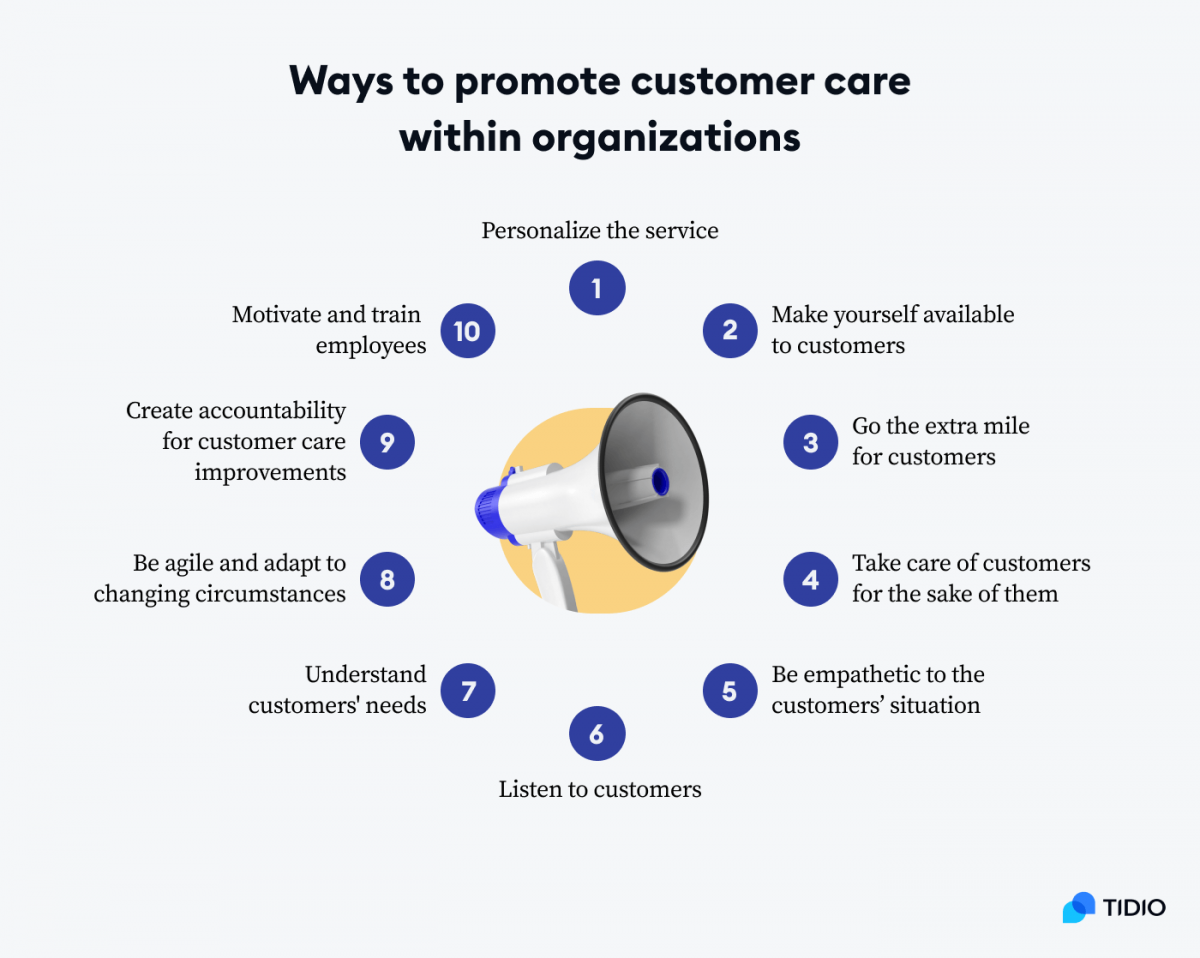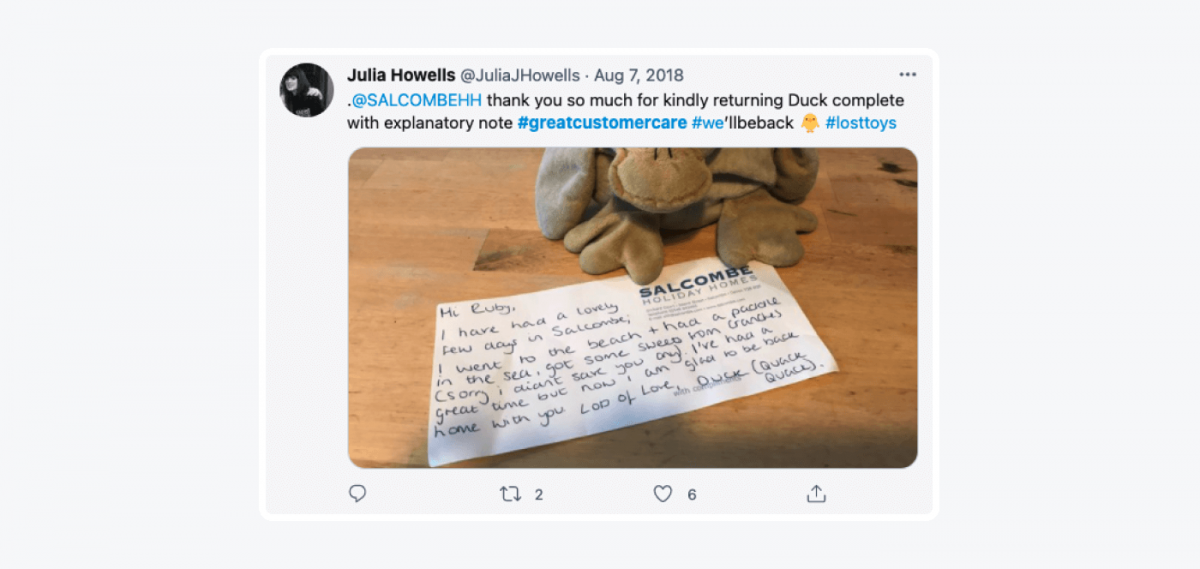Before we jump into the subject of customer care, consider this:
Imagine you had to stay in for a year and a half. Not that hard, is it?
When the time finally arrives for your longed-for vacation, you get stuck at the airport due to the bad weather and staff shortages. No trip to Disneyland, after all.
Now—
The airline has a choice. They can tell you: “It’s beyond us. Next flight tomorrow. See you,” or “Stay calm. We’ll try our best to help you out.”
And this is where the difference between service and care begins.
What is customer care?
Customer care is a way of dealing with customers when they interact with your brand, products, or services to keep them happy and satisfied. Customer care goes beyond customer service and support because it focuses on building emotional connections between brands and customers.
Dr. Jan Louise Jones, professor at the University of New Haven, says the role of customer care is to make a good impression on people. The way a brand handles customer interactions can really distinguish it from others that address similar issues. She says that after all:
People are going to remember how you responded to them in a crisis. Let people know you do care, and you do understand and be genuine with your message.

It seems to be aligned with findings in the 2019 Global Contact Survey by Deloitte. Companies focus on “elevating the human experience” to differentiate themselves from competitors.
Companies in the Deloitte survey reported that customer experience (85%) and service improvement (78%) are their main drivers of investment. In practice, it means adopting a consumer-oriented approach and delivering improved customer care.
Learn how to use AI to boost the quality of your customer service
“Sounds good,” the human in you will say. “But how to measure it?” your business sense will add.
Here’s the thing—
Many aspects of customer care make it hard to come up with reliable customer care metrics. You can use other customer service indicators, though.
For example, customer satisfaction score (CSAT) and surveys, which show how satisfied customers are with the experience. Or net promoter score (NPS), which shows how likely a customer is to recommend the brand to others.
But if you’re too concentrated on measuring the results of your customer care activities, you risk losing focus on creating an emotional bond with clients. You know, it’s kind of like asking your loved one to tell you how much they love you on a scale from 1 to 10, rather than seeing it in their actions.
Moving on.
Customer care is also often confused with other terms, such as customer service, customer experience, or customer relations.
So, to better understand what customer care really means, let’s look at how it fits in interactions with customers.

Is customer care and service the same thing?
The short answer is no. It’s not just another term for customer service.
Customer service’s role is to provide advice and help to customers. It can be helping them choose the right product or deal with complaints. But when you provide customer care, you connect with customers on an emotional level while serving them.
Great consumer care is when you listen to consumers’ needs, understand them, and genuinely care about them. The result is building a long-lasting relationship that benefits both parties—satisfied customers generally exhibit loyal behavior.
Here’s an example to illustrate the customer care vs. customer service difference.
A customer orders a dress online. It’s not delivered on time. The customer makes a phone call to complain. “Sorry about that, here’s a discount to buy a dress in-store.” That’s how customer service works. Problem. Solution. Done. Next!
Now, let’s move on to the consumer care definition—
The same customer arrives at the store the same day. Stressed. The pushchair doesn’t fit between clothes rails. The baby cries.
Now, customer care starts when a shop assistant empathizes with the customer, stops seeing “a customer,” but notices “a mum,” and understands how important it was for her to look and feel good that evening.
The shop assistant invites her to a bigger changing room and takes time to cheer up the baby to ensure the best buying experience possible.
Five years later, the customer still buys from the brand. And remembers the experience when writing an article about customer care.
And yes, I am writing from my own experience.
What is the meaning of customer care in business?
As we’ve already established, customer care is often difficult to define and even more difficult to measure directly. But it plays an essential role in building a positive customer experience, customer relations, and helping customers succeed.
Here’s how—
1. Creates a positive experience for a customer
Customer care occurs when you’re empathetic to the customers’ specific circumstances and work closely with them to offer solutions that fit their needs at a specific time. If a customer receives care on several separate occasions, they all contribute to building an overall positive customer experience.
That said, good customer care translates into:
- Better customer retention
- More positive reviews
- Increased average order value
- Higher customer lifetime value
Each of which is quantifiable and can be expressed in hard metrics.
Customer care vs. customer experience: what’s the difference?
Customer experience is a sum of interactions with a company over different stages of the customer’s journey. Customer care is a one-off experience.
2. Extends the customer relationship beyond the first interaction
Providing customer care can involve all the departments within your organization that interact with customers. Customer service, customer support, product development, marketing, and other departments can all come up with solutions that satisfy customers.
If your brand’s strategy is to take care of existing and new customers just because you care about them, you’ll eventually become their go-to resource. If visitors, leads, and clients see you as their trusted friend they’ll come back to you at different stages of their journey.
Customer care vs. customer relations: how they differ
Customer relations describes how a brand engages with clients to provide an excellent experience. Customer care has a similar goal but is less focused on benefits for your business.
3. Quantifies your target consumers’ key motivators
In customer care, clients aren’t “accounts” or “records” in a database. They are people. So customer care activities recognize and act on the importance of emotions in customers’ decisions. Some of those emotions are shared by the target customer group.
There’s research evidence to indicate that when customers “feel good” about a brand, it increases chances of positive business outcomes, such as closing a sale or getting a partner referral. By identifying the motivators strongly linked to purchases, you’ll know where to invest to strengthen the customer experience.
Customer care vs. customer success: how to tell them apart
Customer success is about educating and onboarding customers and providing technical support when they are in trouble. Customer care focuses on fulfilling the emotional needs of customers.
What is good customer care?
Good customer care comes down to listening to why the customer is angry and doing everything you can to turn a bad situation around. And I really mean everything.
It can sometimes be tricky to pull off, especially if sales-oriented management limits your actions. It takes great leadership that fosters trust and encourages staff’s autonomy and innovation to effectively implement a customer care program.
Essentially, it’s letting employees use available resources to keep clients from losing faith in your company.
It may sound simple, but it’s not that easy. That’s why we’ve prepared a list of examples to better illustrate how employees can care about customers.
Consumer care examples from real people
There’s no one-size-fits-all customer care.
Here are some examples of employees that made something special for customers. In return, the customers became advocates for the brands—which proves customer care’s importance.
1. Taking care of the customers. Because you can
Customer care can sometimes mean doing little “favors” or slightly bending the rules for customers. A small gesture like this can significantly increase customer satisfaction.
A passenger on Virgin Trains experienced this first hand after his son’s hospital stay. They missed a train because of that, and the train manager didn’t make a fuss about changing their travel date.
But that’s not everything—
The train manager moved the family to first-class to make them more comfortable. He didn’t have to go out of the way. But he empathized with the passengers’ experience and took care of their well-being.

2. Going the extra mile to help
This is an example of a support team exceeding the customer’s expectations by immediately responding to his circumstances. This customer who lost a Fitbit watch was able to find it only because the Fitbit support agent helped him track its last location.
Happy customers are the best advocates of your brand. They like to share examples of awesome customer care on social media. It effectively drives word-of-mouth marketing and allows other people to hear about the great way the company treats its customers.

3. Making yourself available to the customers
Here’s another example of employees who care about the customer in crisis. Creating customer convenience is one of the puzzles that go into customer care.
National Tyres employees stayed after hours to help out a customer in need instead of referring them to the FAQ section to check standard business hours.

4. Personalizing the customer care service
Delivering personalized responses to customers is key to building relationships with them. It’s the way to make them feel special and not like another item on a to-do list.
Here’s one of the most impressive examples for delivering a personalized customer service experience I found on Twitter. Ruby, who stayed at Salcombe Holiday Homes, left behind Duck.
Duck wasn’t just sent back to the owner.
Duck was returned to Ruby with a note which explained the toy’s absence. The holiday home customer care team understood what it must feel like for a child to lose a favorite toy and drafted a thoughtful message about Duck’s adventures.
Bottom line?
The family wants to come back to the same place. Just like that, a simple note increased customer loyalty.

Key takeaways
Customer care definition should no longer be confused with other terms used in customer service—it can be a source of real competitive advantage for businesses.
- Customer care is about building emotional connections between companies and customers.
- Its benefits include improved customer loyalty and brand perception, which in the long run increase your company’s revenue.
- Customer care, service, and support build an overall customer experience. The role of the three elements is to satisfy customers and increase their lifetime value.
- Modern consumers tend to share their awesome experiences with wider audiences.
- Small business owners and large corporations can implement the best customer care principles by hiring the right people.
Are you up to being mentioned on social media for delivering excellent customer care?

